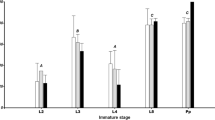Abstract
This investigation deals with the control effects of the insect pathogenic fungus Metarhizium anisopliae var. anisopliae on Daktulosphaira vitifoliae. In pot experiments, the soil surrounding phylloxera-infected grapes was inoculated with barley colonised with M. anisopliae. After thirty-two days, ineight of ten Metarhizium-applied pots nofresh phylloxera infections could be observed.In two of ten plants, a few fresh nodositiessingly occupied with phylloxera or phylloxeraeggs could be found. In all untreated plants,fresh nodosities with either single (two of sixplants) or multiple (four of six plants)occupation with phylloxera could be observed.M. anisopliae could be re-isolated in aconcentration of <1 × 103 CFU g$minus;1 soil dry weight from those pots with phylloxera-infected plants that had been treated with the fungus. The potential role of M. anisopliae in grape phylloxera management is discussed.
Similar content being viewed by others
References
Aregger, E., 1992. Conidia production of the fungus Beauveria brongniartii on barley and quality control during storage at 2 °C. J. Invertebr. Pathol. 59: 2–10.
Butt, T.M. and M.S. Goettel, 2000. Bioassays of entomogenous fungi. In: A. Navon and K.R.S. Ascher (eds), Bioassays of Entomopathogenic Microbes and Nematodes. CAB International, London. pp. 141–195.
Chen, S.Y., D.W. Dickson and D.J. Mitchell, 1995. Effects of soil treatment on the survival of soil microorganisms. J. Nematol. 27(4S): 661–663.
Corrie, A. 1998. Phylloxera problems in Australia and possible solutions. 19. Internat. Geisenheimer Rebveredlertagung, Geisenheim.
English-Loeb, G., M. Villani, T. Martinson, A. Forsline and N. Consolie, 1999. Use of entomophagic nematodes for control of grape phylloxera (Homoptera: Phylloxeridae): A laboratory evaluation. Biol. Cont. 28(5): 890–894.
Ferron, P. 1979. Study of the virulence of some mutants of Beauveria brongniartii (Beauveria tenella) fungi infecting Melolontha melolontha. J. Invertebr. Pathol. 34: 71–77.
Grannet, J., P. Timper and L. Lider, 1991. Deadly insect pest poses increased risk to north coast vineyards. Calif. Agric. 45: 30–32.
Grannet, J., M.A. Walker, L. Kocsis and A.D. Omer, 2001. Biology and management of grape phylloxera. Annu. Rev. Entomol. 46: 387–412.
Jung, C., 1998. Aktuelle Reblausprobleme im Reingau. Geisenheimer Berichte 40: 12.
Leclant, F. and A. Coer D'Acier, 1995. Doit-on á nouveau craindre le phylloxéra? Phytoma 477: 20–25.
Milner, R.J., 2000. Current status of Metarhizium as a mycoinsecticide in Australia. Biocont. News Information 21: 47N-50N.
Porten, M. and L. Huber, 2003. An assessment method for the quantification of Daktulosphaira vitifoliae (Fitch; Hemiptera: Pylloxeridae) populations in the field. J. Appl. Entomol. 127: 157–162.
Presser, C., J. Schmid and E.H. Rühl, 1993. Die Reblaus-kein Problem mehr? Das Deutsche Weinmagazin 23: 22–25.
Redl, H. 1999, Die Reblaus auch in Österreich wieder (beängstigend?) im Kommen. Der Pflanzenarzt 52: 8–12.
Remund, U. and E. Boller, 1994. Die Reblaus-wieder aktuell? Schweiz. Z. f. Obst-und Weinbau 130: 242–244.
Sopp E., E. Bleser, E.H. Rühl, J. Hirschmann, C. Jung and A. Booß, 1998. Reblaus-Aktuelle Situation und Möglichkeit der Schadensbekämpfung. Deutsches Weinbau Jahrbuch 49: 207–214.
Strasser, H., 1999. Beurteilung der Wirksamkeit des biologischen Pflanzenschutzpräparates Melocont_ Pilzgerste zur Maikäferbekämpfung. Der Förderungsdienst 5: 158–164.
Strasser, H., A. Forer and F. Schinner, 1996. The optimization of nutrient media toward the identification and achievment of virulence of Beauveria brongniartii. In: T. Jackson and T. Glare (eds), Microbial Control of Soil Dwelling Pests. AgResearch, Lincoln. pp. 125–130.
Veen K.H., 1968. Recherches sur la maladiaae due a Metarhizium anisopliae, chez le criquet pelerin. Meded. Landbhogesch. Wageningen 68(5): 1–77.
Author information
Authors and Affiliations
Corresponding author
Rights and permissions
About this article
Cite this article
Kirchmair, M., Huber, L., Porten, M. et al. Metarhizium anisopliae, a potential agent for the control of grape phylloxera. BioControl 49, 295–303 (2004). https://doi.org/10.1023/B:BICO.0000025387.13747.74
Issue Date:
DOI: https://doi.org/10.1023/B:BICO.0000025387.13747.74




